Green Group discussion
note: This topic has been closed to new comments.
The Green Group B.C 2009
>
How to use your eyes by James Elkins
date newest »
newest »
 newest »
newest »
 Thanks for this recommendation Michelle, it looks really good, going to try and hunt down a copy this weekend :-D
Thanks for this recommendation Michelle, it looks really good, going to try and hunt down a copy this weekend :-D
 Mike wrote: "This sounds interesting. I will give it a look. Thanks Michelle! -Mike"
Mike wrote: "This sounds interesting. I will give it a look. Thanks Michelle! -Mike"How to Use Your Eyes by James Elkins is one of our Winter book club's selection. I will start and lead a book club's discussion in January. Sam will lead a book club's discussion soon about Green Power by Charles Vrooman. The third book club's discussion is Antarctica 2041 My Quest to Save the Earth's Last Wilderness by Robert Swan that Morgane will lead in January or February 2010.
 How to Use Your Eyes won't tell you how to repair your refrigerator or read bar codes. It's not a museum guide, either you won't learn how to understand fine art. And you won't learn how to predict the weather by looking at clouds, or how to wire a house, or how to track animals in the snow.
How to Use Your Eyes won't tell you how to repair your refrigerator or read bar codes. It's not a museum guide, either you won't learn how to understand fine art. And you won't learn how to predict the weather by looking at clouds, or how to wire a house, or how to track animals in the snow. In short, this is not a reference tool. It's a book about learning to see anything, learning to use your eyes more concertedly and with more patience than we might ordinarily do. It's about stopping and taking the time simply to look, and keep looking, until the details of the world slowly reveal themselves.
The book is divided in two parts, " Things Made by Man ", " Things Made by Nature". I'm going to lead the discussion about How to Use Your Eyes with pictures. Each chapter of the book always ask the same question "How to look at...." with a Natural History's perspective.
I start the discussion with the chapter " How To Look at Grass "
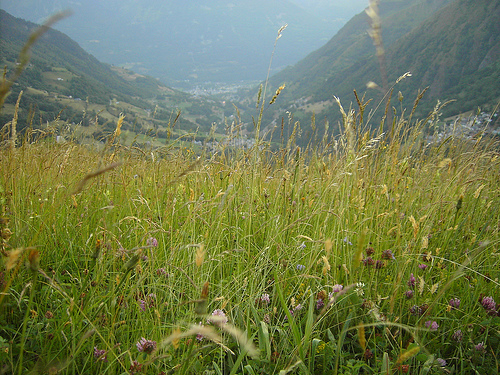
 Here are our goals during this discussion book club.
Here are our goals during this discussion book club." It's about stopping and taking the time simply to look, and keep looking, until the details of the world slowly reveal themselves "
and
" how It will transform your view of nature and the mind "
*************
" People who care about plants tend to like large, gaudy plants. They prefer roses and larger things like oak trees and sequoias.
Grass is a lovely example of an overlooked plant. It would be hard to imagine something more commonly underfoot or more universally unnoticed. It has been estimated that grass covers one fourth of the earth's surface; grasses (Graminae) are the largest family of flowering plants, with somewhere around two thousand species in North America alone.
All the grains we eat are grasses, from oats to barley and wheat. Bamboo is a grass, and so is corn, and so is sugarcane " ( James Elkins, page 21 )
Which percentage of people could identify a field of oats, or rye, or sheep's fescue, or sweet vernal-grass, or timothy, or orchard grass?
 Thanks for your post, Shannon. I was recently reading an article about Education for a Sustainable World and I propose to you this sentence by David W Orr:
Thanks for your post, Shannon. I was recently reading an article about Education for a Sustainable World and I propose to you this sentence by David W Orr:" Education , he writes, " has to do with the timeless question of how we are to live "
Ann, our moderator of The Educators/ Students book club propose two books by David W Orr. Let's join the discussion!
As James Elkins wrote " It has been estimated that grass covers one fourth of the earth's surface" . The first picture of our book club discussion is a picture from France. I'll post some other pictures and you'll find similar pictures in the book.


The Sheep's rescue is one of the most common grasses, a typical roadside grass. It is found from Greeland to New Guinéa, though as a genus it is essentially European.


Sweet Vernal-Grass
It is named for its springlike smell and is found throughout Europe, from northen Scandinavia to North Africa and in the Caucasus, Siberia, Japan, the Canaries, Madeira and the Azores, Greenland and North America.


Timothy, which was brought to America in 1720 by someone named Timothy Hansen for use in grazing, was brought back to Europe in a different form.
 Great! You'll enjoy how delightful it is to "look at ...." . I'll continue the discussion this upcoming week with "How to look at butterflies' wings " and "How to look at the halos"
Great! You'll enjoy how delightful it is to "look at ...." . I'll continue the discussion this upcoming week with "How to look at butterflies' wings " and "How to look at the halos"If you'd like to learn more about plants, I'll recommend to you The Emerald Planet: How Plants Changed Earth's History , a non-fiction book of our world's past - and future - as revealed by plants. Here's its summary.
" Newly found clues in the fossil record show plants to be powerful agents of change, moulding the Earth climate and affecting the evolutionary path of life over the immensity of geological time. These clues reveal how plummeting carbon dioxide levels removed a barrier to the evolution of the leaf; how forests once grew on Antartica, and how giant insects flourished; they strengthen fascinating fossil evidence for an ancient ozone hole, and offer new explanations for past bouts of global warming.
As we face the challenge of a changing, there could be no more important time to take a close book at plants, and to understand the history of the planet through the stories they tell "
Take a look at The Green group's bookshelves, too !
 A fascinating butterfly with an unusual twist: their wings are mostly transparent! Informally known as the transparent butterfly, their official name is the " Glasswing Butterfly" . They are found in Central America.
A fascinating butterfly with an unusual twist: their wings are mostly transparent! Informally known as the transparent butterfly, their official name is the " Glasswing Butterfly" . They are found in Central America.Picture 2
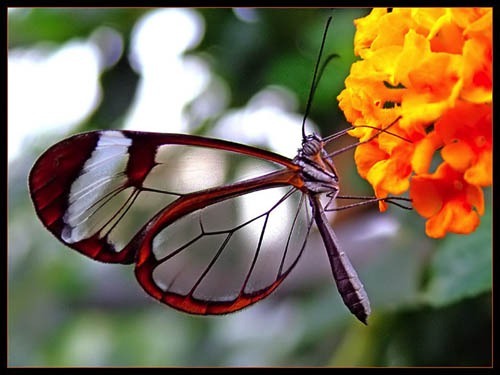
Here's a link from The National Geographic with a lot of wonderful butterflies
http://photography.nationalgeographic...
 All these pictures are beautiful ! I'll add some keys, specially the "ground plan ", a kind of template that is shared more or less by all wings' butterflies.
All these pictures are beautiful ! I'll add some keys, specially the "ground plan ", a kind of template that is shared more or less by all wings' butterflies.
 " A butterfly's wing pattern encodes its identity" (James Elkins)
" A butterfly's wing pattern encodes its identity" (James Elkins)So Shannon, how do you look at butterflies' wings although we are online with 3 pictures ! How to use our eyes......
 Most butterfly (and moth wings) are covered with a dense mosaic of tiny individually colored scales forming a myriad of striking color patterns and designs. This beauty has elevated human perception of butterflies to a level of heightened appreciation.
Most butterfly (and moth wings) are covered with a dense mosaic of tiny individually colored scales forming a myriad of striking color patterns and designs. This beauty has elevated human perception of butterflies to a level of heightened appreciation. Butterflies and moths belong to the order Lepidoptera. This name means "scale-wing" (in Greek) and refers to the scale cell structures found on the wings. As is usually the case with insects, the closer you study them, the more you'll discover. The shape and size of wings varies between species and usually takes on a characteristic shape that may include scalloping, lobes and even trailing hair-like slivers.
 Picture 4
Picture 4[image error]
In a few cases, specific butterfly patterns are more readily associated with functional advantages. The dorsal patternation of butterflies function as gender signals, allowing mates to recognize one another. Advertising your unpaletable nature through bold aposematic (warning) coloration, successfully establishes a learned avoidance response from predators. Camouflage and cryptic coloration have the obvious advantage of rendering the butterfly harder to find. Eyespots (ocelli - picture 4) flashed as an otherwise cryptic butterfly makes a hasty retreat, can confuse an attacker or at least help to focus the attack towards non-critical regions of the body. Melanization is a useful device employed by some butterflies.
 Picture 5
Picture 5Iridescent " Blue Morpho " Butterfly
[image error]
A butterfly has four wings (pictures 1, 3, 5) two forewings (superior) and two hindwings ( inferior). They are attached to the second and third thoracic segments (the meso- and meta-thorax). Strong muscles in the thorax move the wings up and down in a figure-eight pattern during flight.
When the fully-grown adult butterfly emerges from its pupa, its delicate wings are crinkled, wet, and uninflated. The butterfly hangs upside-down and pumps blood into the wings to inflate them. It must then wait for the wings to dry before it can fly. When the fragile wings fray or are torn, they do not repair themselves.
Butterfly wings are made of two chitonous layers (membranes) that are nourished and supported by tubular veins (grey, picture 4 ). The veins also function in oxygen exchange ("breathing"). Covering the wings are thousands of colorful scales, together with many hairs ( picture 4 )
Like all insects, butterflies are cold-blooded. When they get too cold, they warm themselves in the sun.
 The first part of the discussion about How to Use Your Eyes has focused on plants and insects ( butterflies ) which are an important part of our Cultural and Natural heritage on Earth.
The first part of the discussion about How to Use Your Eyes has focused on plants and insects ( butterflies ) which are an important part of our Cultural and Natural heritage on Earth.2010 is the International Year of Biodiversity. Here's a link from " The Unesco " about " The challenges of Biodiversity " with an interview of the Canadian Astrophysicist Hubert Reeves.
http://portal.unesco.org/en/ev.php-UR...
How to preserve our cultural and natural heritage on Earth? How to protect it ? These questions are a part of the discussion leading by Ann at the Educators/Students book club-Winter 2010 with David W Orr's book Earth in Mind: On Education, Environment, and the Human Prospect
 " How to look at the Halos " - The atmospheric phenomena of Halos is an impressive spectacle of nature.
" How to look at the Halos " - The atmospheric phenomena of Halos is an impressive spectacle of nature.The phenomena of halos are arcs or luminous points in the sky, resulting from refraction or reflection of light by ice crystals. These ice crystals that cause the formation of halos are found mostly in the high cloud types cirrus and cirrostratus. One can also observe halos caused by falling snow crystals, ice fog, the snow and ice covered surfaces. The phenomena of halos occur in about 6 to 7 days per month. It appear mostly in the wintertime when it is bitter cold, but it can also happen in warm climates as long as the clouds that cause it are high enough that they are made of ice.
Picture 1
[image error]
This picture give us some details of the halo's phenomena.
- The high part of the photograph, show the "circumzenithal arc " and just under it the "46° halo".
- The center of the photograph show " the upper tangent arc with upper suncave Parry arc "
- The last part show the " 22° halo "
 Picture 3 - The 22° halo
Picture 3 - The 22° haloHave you ever seen a bright halo around the Sun? The fantastic sky display is pictured above and included a 22° degree halo arc. A cloud partially blocked the usually more intense direct glare of the Sun. Such atmospheric ice crystals also cause sundogs and Moon halos. A 22° degree halo has red on the inside and blue on the outside.

"The 22° halo and its sun dogs are only the common members of a whole family of ice halos. Some are not very rare. I have seen the 46° halo, which forms outside the 22° halo and practically fills half he sky " (James Elkins -page 192)
The picture 1 show the 22° and 46° halo.
" A number of physicists have worked on understanding ice halos, and in 1980 Robert Greenler wrote a book that explains virtually all of them. The 22° halo can appear whenever the ice crystals are shaped like little hexagonal columns. Sun pillars are made of light reflected off the top or bottom of thin, pencil-like crystals. Some times the light bounces around inside the crystals, following a complicated path of reflection and refraction (........) time after time he manages to program his computer to produce certain kinds of ice crystals, and the results are a perfect match for halos people have photographed in nature" (James Elkins-page 194)
 And the last part of the discussion of James Elkins's book How to Use Your Eyes presents " How to look at Crystal "
And the last part of the discussion of James Elkins's book How to Use Your Eyes presents " How to look at Crystal "Picture 1
" Pyrite "
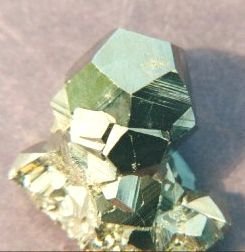 How to Use Your Eyes
How to Use Your Eyes
 Picture 5
Picture 5" The large crystals are especially entrancing because they look so artificial, as if someone had made some random cuts in a piece of glass. Their facets seem to point in all directions without rhyme or reason. But crystals follow very strict and very beautiful laws, and with a simple practice, it is possible to look at a crystal and see how it obeys those laws. When you can perceive the symmetries, the crystal is not just dazzling-it is interesting......." (James Elkins-page 224)
I have added some pictures ( 1,2,3,4,6,7) to illustrate James Elkins's writings and its observations of understanding crystals.
" The apparent chaos is not chaos at all - it is rigorous and simple geometry " (James Elkins -page 231)
The picture 5 show " the Crystal form of the seven crystal system ". How to look at ....Crystal is the last presentation of this upcoming week with some details to understand them.
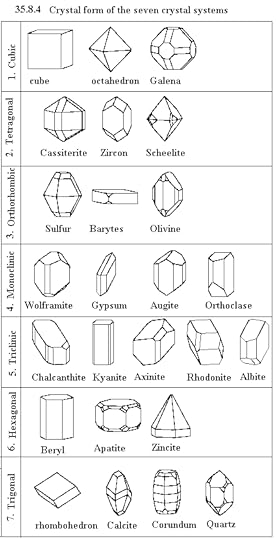
 The six pictures are some species of Crystal from different countries around the world.
The six pictures are some species of Crystal from different countries around the world. Have you ever seen minerals like these pictures?
Have you try to understand how they are built ?
 Shannon wrote: "I have seen pyrite. Not in nature though. For my class this past semester we spent a great deal of time making crystals. It was interesting seeing what different combinations of chemicals produced."
Shannon wrote: "I have seen pyrite. Not in nature though. For my class this past semester we spent a great deal of time making crystals. It was interesting seeing what different combinations of chemicals produced."Could you tell us more about your experience? Which combinations have you seen? Which one was the most impressive or/and instructive ?
 Shannon wrote: "Michelle
Shannon wrote: "MichelleI have finally gotten a copy of the book. Should I start from the beginning of the conversation or just start where you are at?
"
That's great ! We could start at the beginning of the conversation, Shannon.
Would you like to start with grass or butterflies?
I propose to you to post your comments and I'll answer them. I'm online at Goodreads once or twice a day from Paris. Feel free to ask me questions.
So, we could start our conversation!
 As we could see at the picture 5, a crystal form is one of the seven crystal systems.
As we could see at the picture 5, a crystal form is one of the seven crystal systems.The first way to understand them " is to imagine that they are all cut away from some large form, as you might sculpt a big block of wood by sawing off its corners "
For example, you might start with a cube (cubic form of the picture 3 or 5)
" If you bevel each one of the eight corners, you get the next shape in the first row, keep going, planing away each corner equally, the next stop is a very unexpected shape. The original faces of the cube are still visible, and they are still visible, and they are still square, but they are now all bordered by triangles.
In real crystals, the corners may not all be beveled simultaneously. Often only half of the corners will be affected. That "hemihedral" condition is clear enough when its starts, but if you keep paring away those four corners, you arrive at an even more surprising result. And just a little more planing suddenly creates a pyramid. Where is the cube now?
It takes some time to picture how this tipped-over pyramid fits inside the cube.
If we continue beveling the corners of the pyramid, the form gets smaller " (James Elkins, page 226)
" Picturing the hidden shapes is one way to understand crystals. The other way is to imagine that they are built around three axes, as in Euclidean geometry " How it works:
" There is a vertical axis and two horizontal axes, and they meet at the center of the crystal. If the crystal is a cube, the axes touch the middle of each face.
In the cubic or isometric system, all crystals have three perpendicular axes, and each axis has the same length.
 James Elkins's book gives a lot of examples about " Thinks made by man " and " Thinks made by nature "
James Elkins's book gives a lot of examples about " Thinks made by man " and " Thinks made by nature " In the part "Thinks made by man" the author shows, in the same way, a lot of examples in Engineering, Ancient writing system, Linguistic, Art and Art History.
During this month, I have selected some examples of " Thinks made by nature " with two goals:
" It's about stopping and taking the time simply to look, and keep looking, until the details of the world slowly reveal themselves "
" How It will transform your view of nature and the mind "
I have made two experiences (grass and crystal) last week in my courses. I have particularly worked about habits.The results were amazing. I often use these kinds of experience to make students reflect about their feelings, ethics and values about Environmental issues. Why? Because we are often secure in our beliefs and these kinds of experience gives some keys to change habits and take action.
David W Orr wrote:
" Education has to do with the timeless question of how we are to live "
What are your feelings, your mind about nature and which kind of knowledge do we need in Education ?
I have selected three books that I particularly recommend to you. One of them is the fascinating story of Ants by Bernard Werber Empire of the Ants I'm sure that your reading will transform your view about Ants !
The second book is The Emerald Planet: How Plants Changed Earth's History by Davis Beerling
The third one is The Ocean World by Jacques-Yves Cousteau
 Sam wrote: "Thanks for this recommendation Michelle, it looks really good, going to try and hunt down a copy this weekend :-D"
Sam wrote: "Thanks for this recommendation Michelle, it looks really good, going to try and hunt down a copy this weekend :-D"I'm looking forward hearing your thoughts about How to Use Your Eyes - A really good book, Sam :-)
This topic has been frozen by the moderator. No new comments can be posted.



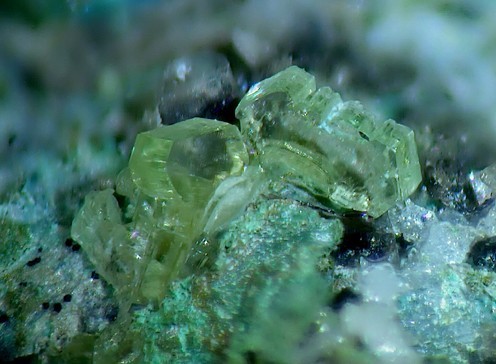



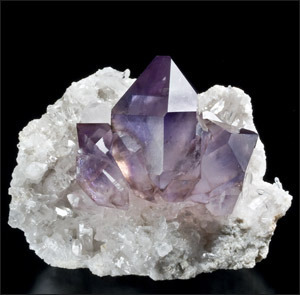


This is a special recommendation for our Winter books's club. Highly recommended!!!
I hope this book will inspire every reader to stop and consider things that are...so clearly meaningless that they never seemed worth a second thought....
Grass, the night sky, a postage stamp, a crack in the sidewalk, a shoulder. Ordinary objects of everyday life.
But when we look at them--really look at them--what do we see?
In the tradition of John Berger's bestselling Ways of Seeing, James Elkins's How to Use Your Eyes invites us to look at--and maybe to see for first time--the world around us, with breathtaking results. Here are the common artifacts of life, often misunderstood and largely ignored, brought into striking focus. A butterfly's wing pattern encodes its identity. A cloudless sky yields a precise sequence of colors at sunset.
How to Use Your Eyes is a thrilling read evocative of the work of Diane Ackerman and Stephen Jay Gould. It will transform your view of nature and the mind.
James Elkins stayed on in Ithaca long enough to get the BA degree (in English and Art History), with summer hitchhiking trips to Alaska, Mexico, Guatemala, the Caribbean, and Columbia.
For the last twenty-five years he has lived in Chicago; he got a graduate degree in painting, and then switched to Art History, got another graduate degree, and went on to do the PhD in Art History, which he finished in 1989. (All from the University of Chicago.) Since then he has been teaching at the School of the Art Institute of Chicago. He is currently E.C. Chadbourne Chair in the Department of Art History, Theory, and Criticism.
His writing focuses on the history and theory of images in art, science, and nature. Some of his writings include scientific and non-art images, writing systems, and archaeology (The Domain of Images, On Pictures and the Words That Fail Them), and some are about Natural History (How to Use Your Eyes).